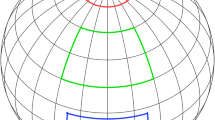Abstract
A reduced latitude-longitude grid is a modified version of a uniform spherical grid in which the number of longitudinal grid points is not fixed but depends on latitude. A method for constructing a reduced grid for a global finite-difference semi-Lagrangian atmospheric model is discussed. The key idea behind the algorithm is to generate a one-dimensional latitude grid and then to find a reduced grid that not only has a prescribed resolution structure and an admissible cell shape distortion but also minimizes a certain functional. The functional is specified as the rms interpolation error of an analytically defined function. In this way, the interpolation error, which is a major one in finite-difference semi-Lagrangian models, is taken into account. The potential of the proposed approach is demonstrated as applied to the advection equation on a sphere, which is numerically solved with various velocity fields on constructed reduced grids.
Similar content being viewed by others
References
Z. Boybeyi, N. N. Ahmad, D. P. Bacon, et al., “Evaluation of the Operational Multiscale Environment Model with Grid Adaptivity against the European Tracer Experiment,” J. Appl. Meteorol. 40, 1541–1558 (2001).
W. C. Skamarock, J. Oliger, and R. L. Street, “Adaptive Grid Refinements for Numerical Weather Prediction,” J. Comput. Phys. 80, 27–60 (1989).
D. Williamson, “Difference Approximations for Fluid Flow on a Sphere,” Numerical Methods Used in Atmospheric Models GARP Publication Series, No. 17 (WMO, Geneva, 1979; Gidrometeoizdat, Leningrad, 1982), Vol. 2.
D. Majewski, D. Liermann, P. Prohl, et al., “The Operational Global Icosahedral-Hexagonal Gridpoint Model GME: Description and High-Resolution Tests,” Mon. Weather Rev. 130, 319–338 (2002).
S. G. Benjamin, G. A. Grell, J. M. Brown, et al., “Mesoscale Weather Prediction with the RUC Hybrid Isentropic/Terrain-Following Coordinate Model,” Mon. Weather Rev. 132, 473–494 (2004).
ICON GCM: ICOsahedral Nonhydrostatic Generation Circulation Model. http://icon.enes.org/
R. L. Walko and R. Avissar, “The Ocean-Land-Atmosphere Model (OLAM): Part II. Formulation and Tests of the Nonhydrostatic Dynamic Core,” Mon. Weather Rev. 136, 4045–4062 (2008).
H. Weller, E. G. Weller, and A. Fournier, “Voronoi, Delaunay, and Block-Regular grid Refinement for Solution of the Shallow-Water Equations on the Sphere,” Mon. Weather Rev. 137, 4208–4224 (2009).
D. L. Williamson and G. L. Browning, “Comparison of Grid and Difference Approximations for Numerical Weather Prediction over the Sphere,” J. Appl. Meteorol. 106, 69–88 (1973).
W. D. Collins, P. J. Rasch, B. A. Boville, et al., “The Formulation and Atmospheric Simulation of the Community Atmosphere Model Version 3 (CAM3),” J. Clim. 19, 2144–2161 (2006).
R. Sadourny, “Conservative Finite-Difference Approximations of the Shallow-Water Equations,” Mon. Weather Rev. 100, 136–144 (1972).
A. Kageyama and T. Sato, “The ‘Yin-Yang Grid’: An Overset Grid in Spherical Geometry,” Geochem. Geophys. Geosyst. 5(9), 1–15 (2004).
X. Li, D. Chen, X. Peng, et al., “A Multimoment Finite-Volume Shallow-Water Model on the Yin-Yang Overset Spherical Grid,” Mon. Weather Rev. 136, 3066–3086 (2008).
A. Qaddouri, “Nonlinear Shallow-Water Equations on the Yin-Yang Grid,” Quart. J. R. Meteorol. Soc. 137, 810–818 (2011).
W. L. Gates and G. A. Riegel, “A Study of Numerical Errors in the Integration of Barotropic Flow on a Spherical Grid,” J. Geophys. Res. 67, 773–784 (1962).
Y. Kurihara, “Numerical Integration of the Primitive Equations on a Spherical Grid,” Mon. Weather Rev. 93, 399–415 (1965).
F. G. Shuman, “On Certain Truncation Errors Associated with Spherical Coordinates,” J. Appl. Meteorol. 9, 564–570 (1970).
M. Jarraud and A. J. Simmons, “The Spectral Technique,” in Proceedings of the 1983 ECMWF Seminar on Numerical Methods for Weather Prediction (Reading, UK, 1983), Vol. 2, pp. 1–60.
M. Naughton and P. Courtier, “A Pole Problem in the Reduced Gaussian Grid,” Quart. J. R. Meteorol. Soc. 120, 1389–1407 (1994).
D. L. Williamson and J. M. Rosinski, “Accuracy of Reduced-Grid Calculations,” Quart. J. R. Meteorol. Soc. 126, 1619–1640 (2000).
G. Jablonowski, R. G. Oehmke, and Q. F. Stout, “Block-Structured Adaptive Meshes and Reduced Grids for Atmospheric General Circulation Models,” Philos. Trans. A Math. Phys. Eng. Sci. 367, 4497–4522 (2009).
R. Yu. Fadeev, “Construction of a Reduced Latitude-Longitude Grid for a Global Numerical Weather Prediction Problem,” Meteorol. Gidrol., No. 9, 5–20 (2006).
P.-O. Persson and G. Strang, “A Simple Mesh Generator in MATLAB,” SIAM Rev. 46, 329–345 (2004).
M. A. Tolstykh, Global Semi-Lagrangian Model for Numerical Weather Prediction (FOP, Obninsk, 2010) [in Russian].
A. Staniforth and J. Cote, “Semi-Lagrangian Integration Schemes for Atmospheric Models: A Review,” Mon. Weather Rev. 119, 2206–2223 (1991).
N. S. Bakhvalov, Numerical Methods: Analysis, Algebra, Ordinary Differential Equations (Nauka, Moscow, 1975; Mir, Moscow, 1977).
C. Temperton, M. Hortal, and A. Simmons, “A Two-Time-Level Semi-Lagrangian Global Spectral Model,” Quart. J. R. Meteorol. Soc. 127, 111–129 (2001).
D. L. Williamson, J. Drake, J. J. Hack, et al., “A Standard Test Set for Numerical Approximations to the Shallow Water Equations in Spherical Geometry,” J. Comput. Phys. 102, 211–224 (1992).
S. A. Doswell, “A Kinematic Analysis of Frontogenesis Associated with a Nondivergent Vortex,” J. Atmos. Sci. 41, 1242–1248 (1984).
R. Nair and B. Machenhauer, “The Mass Conservative Cell-Integrated Semi-Lagrangian Advection Scheme on the Sphere,” Mon. Weather Rev. 130, 649–667 (2002).
M. Zerroukat, N. Wood, and A. Staniforth, “A Semi-Lagrangian Inherently Conserving and Efficient Scheme for Transport Problems,” Quart. J. R. Meteorol. Soc. 128, 221–224 (2002).
M. Zerroukat, N. Wood, and A. Staniforth, “SLICE-S: A Semi-Lagrangian Inherently Conserving and Efficient Scheme for Transport Problems on the Sphere,” Quart. J. R. Meteorol. Soc. 130, 2649–2664 (2004).
M. A. Tolstykh and V. V. Shashkin, “Vorticity-Divergence Mass-Conserving Semi-Lagrangian Shallow-Water Model Using the Reduced Grid on the Sphere,” J. Comput. Phys. 231, 4205–4233 (2012).
Author information
Authors and Affiliations
Corresponding author
Additional information
Original Russian Text © R.Yu. Fadeev, 2013, published in Zhurnal Vychislitel’noi Matematiki i Matematicheskoi Fiziki, 2013, Vol. 53, No. 2, pp. 291–308.
Rights and permissions
About this article
Cite this article
Fadeev, R.Y. Algorithm for reduced grid generation on a sphere for a global finite-difference atmospheric model. Comput. Math. and Math. Phys. 53, 237–252 (2013). https://doi.org/10.1134/S0965542513020073
Received:
Accepted:
Published:
Issue Date:
DOI: https://doi.org/10.1134/S0965542513020073




